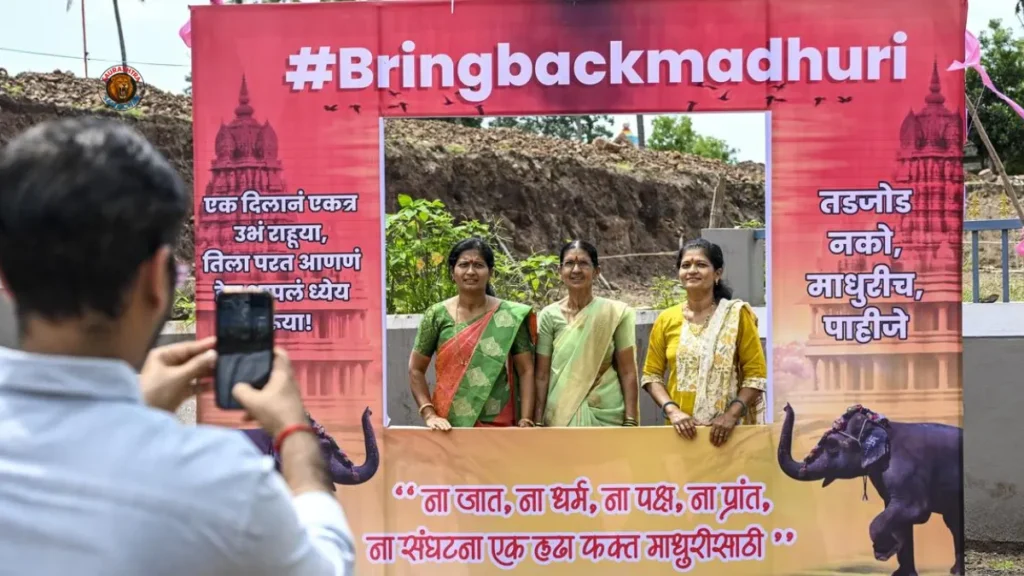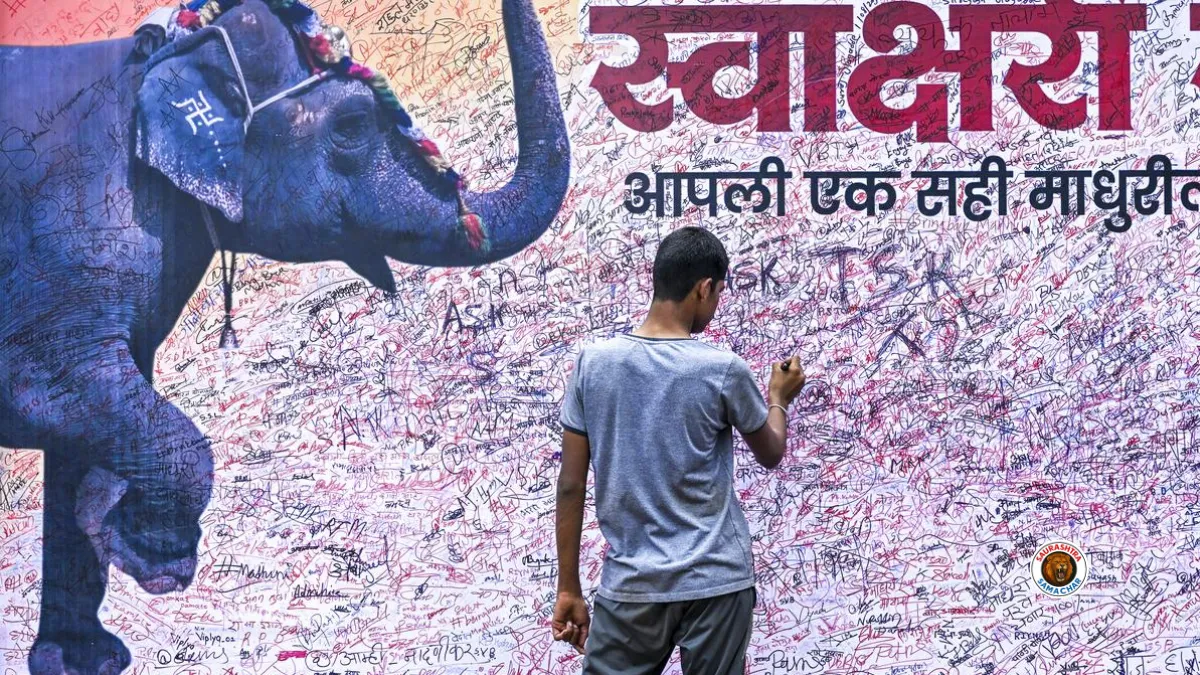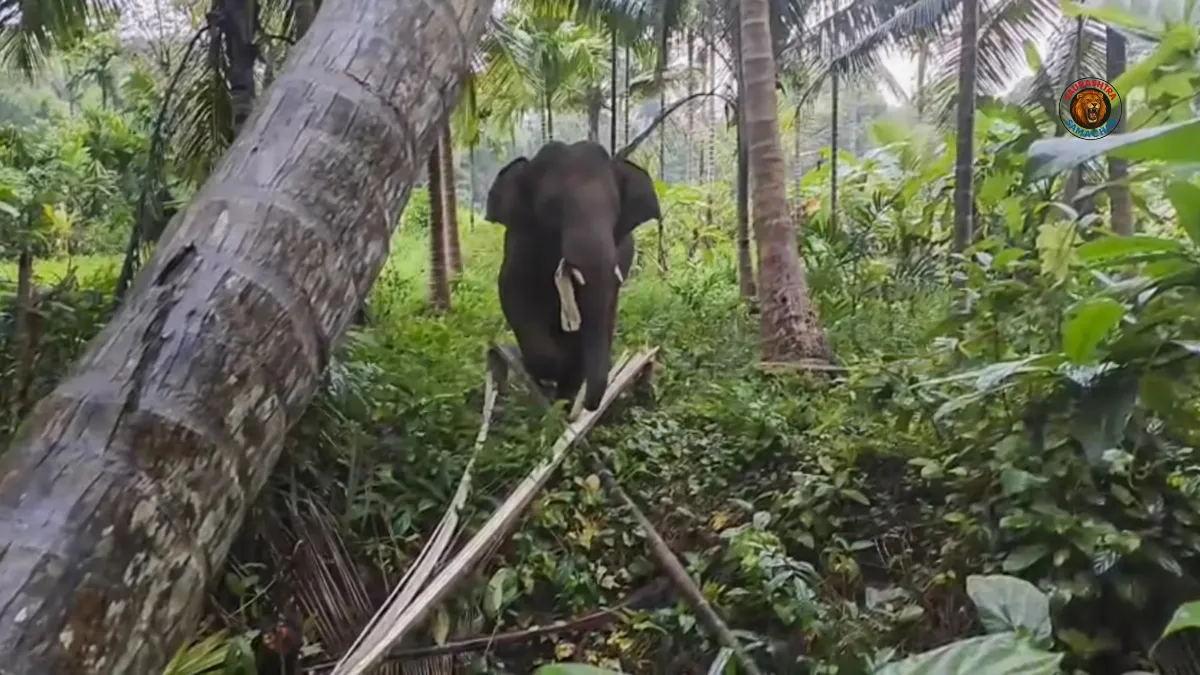Madhuri elephant: Every year, the rains in August bring happiness to Kolhapur, a lush region in Maharashtra’s sugarcane belt. The fields turn green, farmers breathe a sigh of relief, and life seems to regain its energy. But this year, the villages of Kolhapur are filled with grief instead of joy.
The reason? Madhuri elephant, also known as Mahadevi, has been taken away from her home.
Madhuri, a 36-year-old elephant, was moved from Nandani village to Vantara, a large wildlife rescue and rehabilitation center in Jamnagar, Gujarat, run by the Ambani family. The distance between her old home and this new facility is over 1,170 kilometers.
Her longtime mahout (elephant caretaker), 56-year-old Ismail Nidgun, is heartbroken. “It feels like I have lost my daughter. My days are empty just like this gajshala (elephant home),” he says. Originally from Davangere in Karnataka, Nidgun had been looking after Madhuri for the last seven years.
The order to transfer Madhuri elephant came on July 28, following a Supreme Court directive. She had been living at the Shree Digambar Jain Atishay Kshetra Vrishabhachal, a 1,300-year-old Jain mutt, but was sent to Vantara, described on its official website as “Anant Ambani’s dream project.” Anant Ambani, son of Mukesh Ambani, is known for creating a massive facility dedicated to rescuing and rehabilitating endangered animals.

A Village in Protest
On August 3, thousands of villagers gathered early in the morning and began a 40 km protest march from Nandani to the Kolhapur District Collectorate. They demanded that Madhuri elephant be brought back.
“Did Ambani get only our Madhuri to take?” asks Mahavir Jugale, a 56-year-old farmer from Nandani.
In the busy market area of Gandhi Chowk, shopkeeper Vijay Teli recalls, “It’s like separating a child from her mother. Whenever we hear the sound of a bell, we still think Madhuri is coming.” Madhuri always wore a bell around her neck, and the sound had become part of the village’s everyday life. Children would line up just to touch and play with her.
Everyone in Nandani has a special memory of the Madhuri elephant.
Court Orders and Controversy
The Supreme Court’s July 28 order upheld an earlier Bombay High Court ruling to transfer Madhuri to the Radhe Krishna Temple Elephant Welfare Trust (RKTEWT), which is part of Vantara and registered in 2019.
Vantara is huge — it covers 998 acres and, according to official records, houses 238 elephants. It claims to be committed to “rescuing, rehabilitating, and protecting endangered species.”
However, many locals strongly disagree with the decision.
Sushila Kambhoje, a 70-year-old resident living near the mutt, questions the reasoning: “They called Madhuri dangerous and sick. How could she be dangerous? On her farewell day, 2,000 people surrounded her. Did she hurt even one person?” Sushila has known Madhuri since she was three years old. The elephant had been brought to the mutt in 1992 from the Sakrebailu elephant camp in Shimoga, Karnataka.
The mutt, which plays an important role in the Digambar Jain community across parts of Maharashtra and Karnataka, has a long tradition of keeping elephants for religious and cultural purposes. Elephants like Madhuri have been part of festivals such as Ganeshotsav and Muharram. “We treated her like family. PETA’s claims that she was distressed are false,” says the mutt’s financial manager, Shirish Herwade.
PETA’s Allegations
PETA (People for the Ethical Treatment of Animals) claims that Madhuri elephant was suffering from multiple health issues, including foot rot, overgrown nails, abscesses, arthritis, and behavioral distress. These details come from a report by a High-Powered Committee (HPC) approved by the Supreme Court.
The HPC was formed after a public interest litigation filed in 2022 by lawyer Sudipta Nath, who wanted an investigation into past elephant transfers to RKTEWT.
Following public protests, the Maharashtra government stepped in, holding meetings with both the Kolhapur delegation and the Vantara team. On August 6, Chief Minister Devendra Fadnavis announced that Vantara had offered to create a satellite rehabilitation center in Nandani and join the government’s court request to bring Madhuri back.
Vantara issued a statement saying it was only following court orders and its role was limited to caring for the elephant.
What the Proposed Center Includes
Vantara’s proposed center in Nandani would have facilities such as:
- A hydrotherapy pond for joint and muscle treatment
- A large water body for swimming and exercise
- Laser therapy and rehabilitation treatment rooms
- A covered night shelter and open space for movement without chains
- A sand pit and on-site veterinary clinic
But villagers argue that all this could have been set up locally from the start instead of moving the Madhuri elephant far away.
Between the Mutt and the HPC
The mutt’s leadership accuses PETA of acting as a mediator for powerful groups and says that Vantara has been collecting elephants from all over India. They point out that the mutt had a valid ownership certificate under the Wildlife Protection Act, 1972.
PETA rejects these claims, stating that the decision was made by the HPC and that the mutt had violated wildlife laws multiple times. “The temple had every opportunity to present their case but failed,” says Khushboo Gupta, PETA’s Director of Advocacy.
Interestingly, Madhuri elephant is not the first from Maharashtra to be taken to Vantara — another elephant from Sangli district’s Vita was also transferred there.
Inspection Reports
An HPC sub-committee visited the mutt on June 12, 2024, and confirmed that Madhuri’s diet and health were being maintained, though they suggested more opportunities for socialization.
Three months later, senior forest officer Vivek Khandekar inspected the mutt again and noted improvements — her back and toenails were in better shape, she was walking properly, and she was enjoying daily walks of 5–10 km and weekly baths in the Panchganga River.
The mutt claims they implemented all recommendations within three months, so there was no need for relocation.
A Village United
Across Nandani, banners and posters read: “One Signature for Madhuri”. An online petition launched by MLC Satej Patil gathered over 2 lakh signatures from across India, which were sent to President Droupadi Murmu.
Meanwhile, a ‘Boycott Jio’ campaign spread across Kolhapur, with 743 villages participating and thousands of people switching their phone networks in protest. Former MP and farmer leader Raju Shetti, who led the campaign, even alleged that PETA had offered him ₹2 crore to convince the mutt to give up Madhuri.
Also read: World Lion Day 2025: The Lion’s Royal Legacy in Mughal India
More Complaints from Other Places
Concerns have been raised in other districts too. In neighboring Sangli, the Ganpati Panchayatan Devasthan Trust says they were offered an “unfit certificate” for their elephant Gauri to be sent to Vantara. Similar stories have surfaced from Karnataka’s Belagavi and Raichur districts, as well as cases involving elephants named Padma, Dhurva, and Meenika.
Environmental experts say the lack of government-run rescue centers is forcing reliance on private facilities like Vantara. “While Vantara offers excellent resources, depending entirely on private hands is risky,” says conservationist Sagnik Sengupta.
The Bigger Question
The Madhuri elephant case is not just about one animal. It has opened a wider debate about who should care for India’s elephants — local communities who have known them for decades, or large private facilities with advanced resources.
For Nandani’s villagers, Madhuri was more than an elephant — she was a family member, a festival participant, and a friend to children. Her absence has left a deep emotional void, and the fight to bring her back is far from over.














